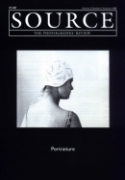Rencontres d'Arles
Review by Christophe Chabot
Issue 9 Autumn 1996
View Contents ▸
Since 1970 the town of Arles in the South of France has during the first week of July been a place where people involved with photography meet. It is the home of Rencontres Internationales de la Photographie.
Exhibitions, conferences, workshops open to participation and slide-shows in the amphitheatre at night are some of the reasons that might lead one to cross France or Europe to spend time in Arles at this time of the year. One can also have work looked at, make or revive contacts so that people know that you still exist and inform oneself of the latest technological developments if only to satisfy one's curiosity. One can find many other reasons to go to Provence such as tourism and gastronomy and the best one can hope to do is combine business with pleasure.
Until 1994, the artistic director of the festival had been, almost by tradition, its founder Lucien Clerque. In order to revitalise the Rencontres it was decided that a new artistic director would be nominated every year. After a false start last year (about which we will not speak) this year's programme had to be, and was, a success. The festival was coherent and the fruit of reflection about the medium of photography. If the exhibitions were of an uneven quality, this was perhaps unavoidable in an event of this size. Testing the BK-50 electronimagnetic balloon in 1928. Photograph by Olli Lehtinen.
Testing the BK-50 electronimagnetic balloon in 1928. Photograph by Olli Lehtinen.
This year's artistic director, Joan Foncuberta, is involved with photography on many levels; as an artist, a theoretician, a critic, an historian and a teacher. 'Reals, Fictions, Virtual' was the title given to the 27th Rencontres. One might be able to guess that the artists shown this year in Arles were those whose reflections on the medium are an extension of Foncuberta's own preoccupations. To characterise them in a few words, they are concerned with the credibility we give to photographs because of their particular relation to the world. For Foncuberta, reality doesn't exist. It is a cultural construction and photography is a means of analysing this model. Photography is a fiction; it is not defined by a technology but by a look, a culture. Photographs have an authority which allows them to impose falsification and the fictional construction of 'reality'. The message one gets after visiting this festival is that one has to be cautious of the image.
Foncuberta's strategy - in his own work as well as that which he chose to show of other artists during the Rencontres - is to confront the public with images, documents and photographs which make the viewer lost in doubt; Is all this true or false? One exhibition that exemplified this was the history of Bonk Business Inc. P. Bonk and Co., it would appear, 'was formally established in 1843 by Par Bonk'. The archive image opposite shows the Bonk 'Electromagnetic Meteorological Balloon' powered through the interaction of cosmic rays with radon charged enochite dust. It is just one of the many incredible inventions from the company which has manufactured the 'Tektomo', an all weather electromechanical diviner 1929, and 'Phero-1 the isolated organic pheromone therapy inhalator'. Barry Bonk, 'the present leader of the multicultural family, now over 250 strong, lives reclusively on God's Lake in Northern Canada with the Anchovak Indians of whom he is now chief'.
Foncuberta concentrates on how to captivate the public's attention, perhaps because he thinks art is often too serious, and his programme was entertaining. William Wegman lets his dogs Man Ray and Fay Ray play the role of humans and makes videos and photographs of them. These have recently been borrowed in a Smirnoff Vodka ad. campaign (remember the dog in the Pink feather boa?).
Photography is a very broad language used in applications such as advertising, communication, daily life, science and industry as well as art. Foncuberta wants to deal with this richness of the medium in order to teach us that it concerns everybody on some level. The works shown in Arles embraced the wide panorama in which photography is used.
Other articles on photography from the 'Multi-Genre' category ▸






